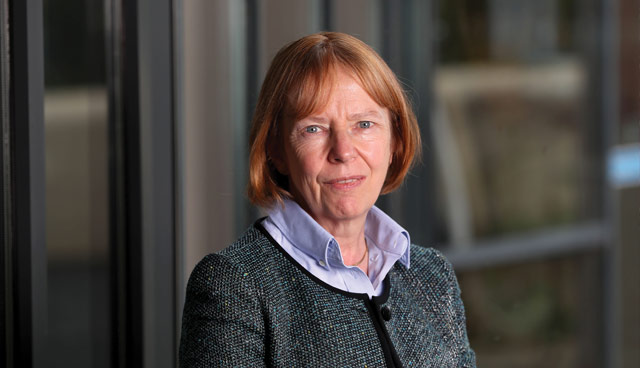Infrastructure: A driver of productivity and growth

Kate Barker of the National Infrastructure Commission offers insights from the UK’s first National Infrastructure Assessment, demonstrating why infrastructure is a key foundation of economic productivity and growth.
Barker provides a brief overview of the three core objectives of the National Infrastructure Commission: supporting economic growth across the UK, improving the competitiveness of UK business and improving the quality of life of UK citizens. “Increasingly, I feel we are steadily growing tired of talking about things like growth and productivity,” she explains, “and we are now more concerned about quality of life, something which we rely upon infrastructure to deliver.”
Barker explains that the island of Ireland displays many well-known infrastructural features which create both challenges and opportunities for prospective planners and providers. She highlights the entirely subsidised water system across the island, a limited and sometimes poor connectivity to the gas grid and a continued dependence on fossil fuels for home heating. Whilst Northern Ireland’s access to an increasing capacity of renewables is highlighted as an opportunity, Brexit and Northern Ireland’s all-island energy market link to the Republic of Ireland are both highlighted as challenges.
Inextricable links
Regardless of infrastructural challenges or opportunities, Barker’s overarching message is that infrastructure is inextricably linked to productivity. “One of the first things the Commission did in its early days was collect information on the links between growth and infrastructure. There is evidence that better infrastructure supports better economic growth, and that evidence is particularly strong where you have new networks,” claims Barker, explaining the relationship between the concepts. “For example, the introduction of railways into the United Kingdom had an immensely positive effect upon productivity. More recently, the move towards digital has transformed our everyday lives,” claims the economist. “Nevertheless, whilst we aren’t seeing as many huge infrastructural developments as we have seen over the past 100 plus years, updating and maintaining what we do have is very important.”
Barker draws attention to the region’s productivity level, currently at 20 per cent below the UK average. “One of the things we have argued has been around the question of how infrastructure can create more productive cities. It’s true in the UK that all the cities outside of London have a lower rate of productivity than the national average,” she admits. However, the economist insists that such cities have the potential to be just as productive as other cities in Europe, provided they are equipped with “the correct infrastructure”.
“When we look in more detail, we can see for example that London and Manchester have benefitted from having their own mandate to transform their transport infrastructure. We argue that other cities, both large and small, need to be given the opportunity to take a similar approach, and that would apply as much to Belfast as it would to Birmingham or Bradford,” states Barker. “Infrastructure helps realise the potential of new technologies. Full-fibre digital infrastructure and urban transport lower the costs of connecting firms, workers and consumers. It also helps us to capture the benefits of higher productivity that you get when you have dense clusters of firms fostering innovation. It will help us move towards a low-carbon economy and towards electric vehicles,” she adds, highlighting emerging technologies in the fields of data capture and analysis, and their capacity to generate high-quality data. It is suggested that this can assist leaders with more effective planning of new projects, whilst guaranteeing stronger maintenance of existing infrastructure.
A digital future
Barker draws attention to the requirement of the Commission to publish a National Infrastructure Assessment for the UK every five years. The first Assessment, published in July 2018, covers six priorities; the UK’s digital future is discussed as one of the first elements of the report.
“We know businesses and families want better broadband, and data suggests that we are reaching the limits of our existing copper network. So, we have argued for full-fibre broadband nationwide to promote digital connectivity, whilst boosting productivity and competitiveness,” she explains, outlining the productivity benefits of fresh and well-equipped fibre networks. “Full fibre is up to 1GB faster for upload and download speeds. It’s reliable; it has five times fewer faults than the old copper network. It’s also cheaper to run, offering an operational expenditure saving of up to £5 billion up to 2050.”
The economist suggests that only governments are capable of launching such large-scale infrastructural projects. Indeed, governments are highlighted as the only bodies capable of ensuring that rural areas can enjoy the full benefit of full-fibre broadband, as “the private market is unlikely to commit to that in the short term”. With some optimism, Barker welcomed statements in the Government’s Future Telecoms and Infrastructure Review which mirrored many of the Commission’s concerns, including the need to invest in full-fibre broadband in rural and remote areas.
Infrastructure is not only intertwined with productivity and economic growth. Barker argues that infrastructural investment and innovative design can begin to address the climate challenges facing the island of Ireland. “Recently, we had the stark warning from the Intergovernmental Panel on Climate Change about what will happen if we don’t act now to protect the environment in the future. Far from where we thought we were heading, it is now clear that without immediate action, we may be moving towards double the initial rise in emissions,” warns Barker. “We have a lot of work to do to achieve a truly low carbon economy. In particular, we need low-carbon alternatives to fossil fuel for our heating. So, the Commission has looked at alternatives, including heat pumps and hydrogen gas,” she adds.
Low carbon, low cost
Investment in built infrastructure and low-carbon sources can also cut costs, according to Barker, who argues that Northern Ireland can create a low-carbon electricity system powered mainly by renewables as a low-cost option, compared to nuclear power stations. “We have taken a strong view that renewables are a safer bet than moving to new nuclear power plant. Northern Ireland is in a good position on low carbon energy, as by the end of this year, electricity generation will surpass peak demand levels for the first time.”
A more structured approach to waste management is highlighted as a crucial requirement of strong productivity. Barker highlights the findings of recent research conducted by the Commission, which found that 50 per cent of people would pay up to £30 a year for more recyclable packaging, while 79 per cent indicated they would be happy to separate their food waste. “Our findings led us to propose tougher targets on recycling, particularly on plastics. Separating food waste helps to lower costs and create biogas,” she says. “To have a national recycling scheme would be beneficial. To implement this, government or local authorities will have to set targets, whilst providing financial support for those switching from the current system to the one that we propose.”
In December 2018, the Government published its Resources and Waste Strategy, which includes measures in line with recommendations in the National Infrastructure Assessment, including national standards for recycling to be in place by 2025, and weekly collections of food waste that can enable the production of biogas.
The adoption of low-carbon technologies, particularly the increased uptake of electric vehicles, is welcomed by Barker as a catalyst in the move towards a low-carbon economy. Indeed, it is noted that UK sales rose by a fifth over the past 12 months. “They [electric vehicles] give us cleaner air, and that’s really important to health and quality of life. They are three times more cost efficient than petrol, and provide flexibility for the energy system, since people can use smart charging when electricity demand isn’t very strong. In this way, renewable energy can be spread across a 24-hour cycle,” she states. “We aren’t going to get this if we don’t have a truly national and visible network, and we will need the public sector to subsidise this where the market won’t, starting with rural areas. We also want councils to allocate more of their parking spaces to cater for future electric vehicle charging facilities.”
When it comes to solid infrastructure, it’s not all about appearances. Approaching the end of the discussion, the economist concludes that “If we are going to have good infrastructure, then we have to ensure it is well designed. It’s not simply about aesthetics: it must work for all the people who use it. To this end, we are establishing a dedicated Design Panel to support the Commission.”
“It’s not just governments we want to take action. We also want regulators, industry and others to contribute. I believe that this infrastructure vision can help us rise to the productivity challenge.”





